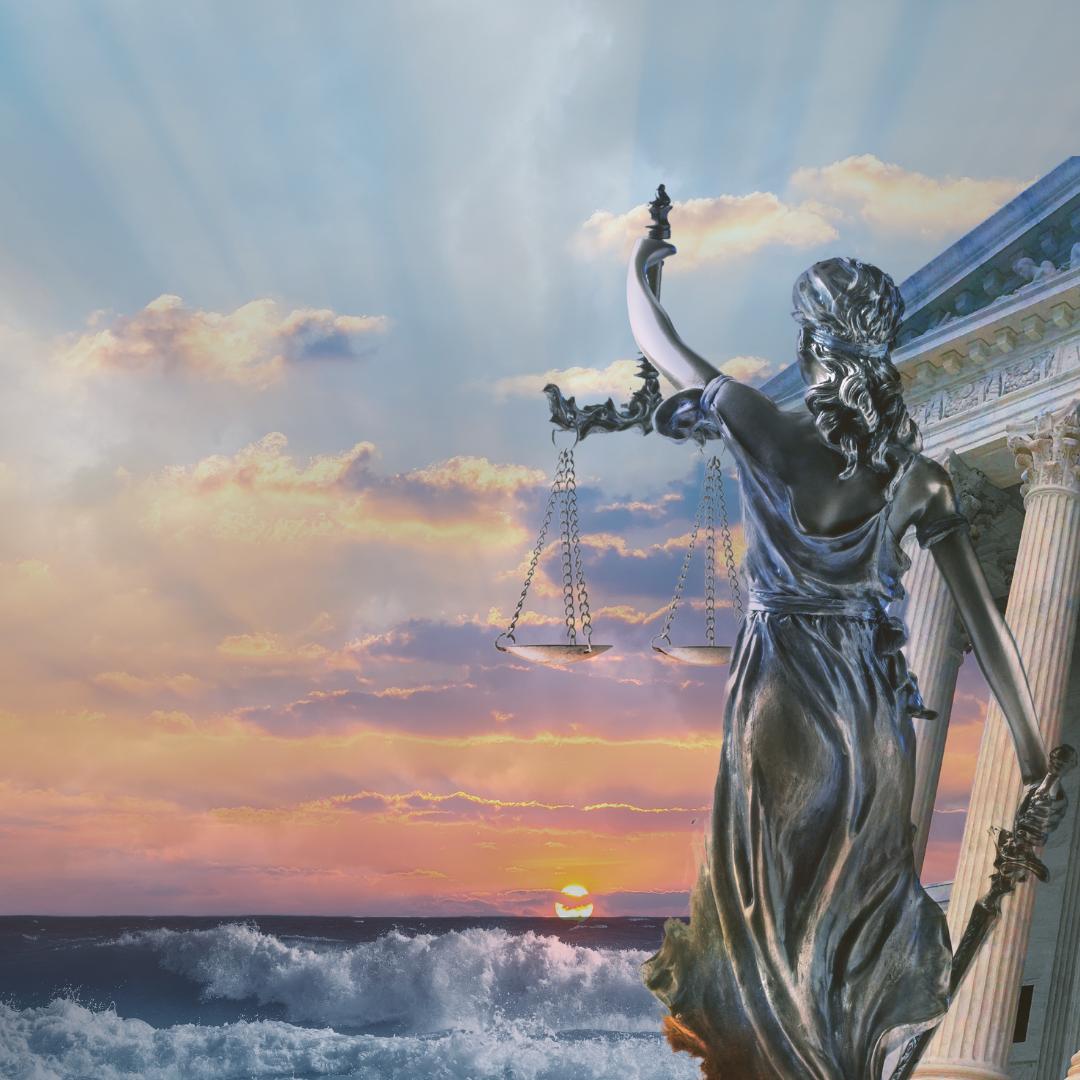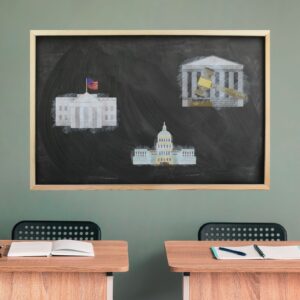
Author: Caled Al-Adsani
Editors: Shipra Mishra and Muhammad Hani Ahsan
Graphic by: Ava Lagressa and Norie Wright
Introduction
In the cultural imagination, public administrators take on two distinct forms. The first is of the bureaucrat whose work is mundane and works in offices reminiscent of the Department of Motor Vehicles. The second is of the secret government variety, a cabal of Belgium bureaucrats who hold the reins of power and supplant the will of democracy. Those who have any experience with a public administrator know that they lean towards the former. However, unbeknownst to many, public administrators wield a significant amount of decision-making authority and have used it to shape policy implementation for decades. This power is Chevron deference and has been the cornerstone of the administrative state in the United States since 1984.
Background
Chevron deference refers to the 1984 Supreme Court case Chevron U.S.A., Inc. v. Natural Resource Defense Council, inc. The case was about a bubble provision implemented by the EPA regarding the Clean Air Act. Under EPA regulations, a state could allow for a plant-wide definition of a ‘stationary source’. This would allow polluters to install or modify one piece of equipment without meeting permit conditions, so long as total emissions did not rise. The bubble provision would then allow companies, like Chevron, to use all polluting devices in the same industrial grouping to count as one entity.1 In essence, the question the Court was to decide on whether the bubble provision fell within a reasonable interpretation of the law by regulators.
To someone without any legal training or background, this case can seem removed from the topic of public administrators. One may ask, how does a bubble provision affect the entire federal administrative state? While the case was about a bubble provision, the argument behind the case revolved around the limit of interpretive power administrators had over legislation. As argued by Paul Bator, the lead attorney representing Chevron, “Our position is that even if the definition applies, the most sensible reading of it is that within the definition there is room to adapt and that the Congress must have intended some administrative discretion.”2 The case was an attempt to answer whether the administrators had the right to form their reasonable interpretation of the law, without Congressional intent or interpretation.3
The Supreme Court, deciding unanimously in support of Chevron, expanded the power of administrators significantly. As stated in the majority opinion, written by Justice Stevens, “The Administrator’s interpretation represents a reasonable accommodation of manifestly competing interests, and is entitled to deference.”4 The deference Chevron provided for administrators gave them the power of reasonable interpretation. Further, regarding the patchwork nature of the regulatory state, administrators could make decisions when regulations are contradictory or implicit. The 1984 Chevron case gave public administrators the power to interpret laws and regulations and consequently changed the entire administrative state.
Chevron As An Innovative Practice
Chevron deference is instrumental in providing interpretive powers to public administrators. Interpretative powers refer to the ability to implicitly determine the scope of legislation, holding only judicial review as a nullifier of the interpretation. Before Chevron deference, the power of statutory interpretation was held by Congress and could only be shared with public administrators if the power was explicitly delegated to them.5 If a concern arose over interpretation, the question was sent to the Courts for the final say. This created difficulties for the Courts, Congress, and public administrators. For the Courts, the work of interpretation was significant and inundated judges with work on minor statutory issues. For Congress, it forced their legislation to be extremely specific, making it more difficult to pass legislation as compromises around the wording of the legislation were lost. Without Chevron deference, public administrators were limited in their ability to efficiently and effectively administer legislation as small nuisances could slow down statutory application. Ultimately, Chevron deference reflected an evolving bureaucracy that was increasing in size and scope, changing the very balance of power between the branches of government.6 Although seemingly hyperbolic in scope, Chevron deference has been used in more than 19,000 cases and has been fully integrated into the legislative process.7
The Debate over Chevron
The establishment of Chevron deference has sculpted the landscape of the administrative state for nearly four decades. However, it is at risk of being overturned. In the case, Loper Bright Enterprises v. Raimondo, the issue of Chevron deference will be ruled on by the current Supreme Court, whose makeup of six conservative justices to only three liberal justices, all but ensures its demise.8 Loper Bringt Enterprises V. Raimondo involves a group of commercial fishermen suing the National Marine Fisheries Service after they required certain fisheries to fund at-sea monitoring programs.9 Although the District Court and the U.S. District Court of Appeals for the D.C. Circuit sided with the National Marine Fisheries Services, the Supreme Court still decided to hear the case.10 The lack of precedent of cases revolving around Chevron deference highlights the Supreme Court’s theoretical desire to overturn Chevron deference despite the consistent rulings from the lower courts.
Speaking in defense of Chevron, Justice Kagan, one of the three liberal Justices on the Supreme Court, stated that federal agencies, with their specializations, are more qualified at resolving ambiguous legislation than the Courts.11 Justice Sotomayor concurred with Justice Kagan and continued by postulating that the Court may not be able to find the ‘best’ interpretation of the law as it ‘routinely disagreed’ and suggested that the expertise of agencies would be best suited as a kind of deciding factor.12 Justice Brown also highlighted its necessary role in filling gaps and interpreting legislation, responsibilities which the Courts would be forced to take on if Chevron deference were struck down.
The conservative Justices seemed to be less wary in deciding the functionality of Chevron deference but were rather impartial to what a future without Chevron deference would look like. Chief Justice Roberts stated that the effect of overruling Chevron would be minimal as the Supreme Court had not needed to cite the ruling in years. However, it was noted that lower courts still use the case considerably. There was significant disagreement about whether overturning Chevron would open previous rulings to new litigation which would cause a storm of challenges across what very well may be thousands of rulings. There is also the possibility that the Chevron ruling may be limited in some manner, rather than a complete overrule. Still, the shades of nuisance surrounding that compromise could only be discovered behind the Justices’ chamber doors. The future without Chevron deference may be turbulent.
Justice Kavanaugh, regarding the current implementation of Chevron, stated that it currently, “Ushers in shocks to the system every four or eight years when a new administration comes in.”13 In essence, Justice Kavanaugh opines that, far from providing the stability cited by many proponents of Chevron deference, it creates instability in the regulatory state. This is because each successive presidential administration gains power over the federal bureaucracy and in so doing, can use the interpretive powers of Chevron deference to limit or expand federal regulation. Justice Kavanaugh sees this as an abdication of interpretive powers by the Courts.14 Some may sympathize with the views presented by Justice Kavanaugh but it is important to note the self limitations imposed upon the deferential system established by Chevron. The Courts have been fairly dismissive of Chevron, with the lower court’s ruling against agencies using the Chevron precedent forty percent of the time and the Supreme Court ruling against it seventy percent of the time.15
Regardless of its implementation, the debate over Chevron deference highlights a few distinct questions that still need to be answered. The first is about the scope and powers of federal agencies without Chevron deference. Without the ability to interpret, their powers would be considerably curtailed and the administrative state would have to heavily rely on explicit legislation from Congress or interpretations by the Courts. Without either, the regulatory power of federal agents would be muted. The next important question is how does the Courts cope. Depending on the degree of dismantling, the end of Chevron deference could result in the powers of interpretation returning to the Courts. The implication of a shift in power towards the Courts would be politically significant because whoever had the most influence over the Courts, whether liberal or conservative judges, would have the power of interpretation. To be clear, this would create a kind of dual-minded approach to interpretation where liberal and conservative Justices, at all levels of the Court, would fight over interpretation. How the judicial system, as currently constructed, would adapt to those kinds of pressures from within and without, holds massive consequences. Finally, the necessity to draft detailed legislation would further complicate Congressional deliberations over potential legislation. The issue is compounded by the political swing of the Court as the detail associated with the proposed legislation is dependent on how Congress believes its legislation would be interpreted.
Ultimately, the ending of Chevron deference would bear huge consequences. Although the challenge to the over forty-year-old precedent is in regards to the fishermen arguing against paying for federal observers, the implications are significantly broader. The effect Chevron deference has would be completely undermined after its turnover. Such an inevitability would result in the complete reordering of federal legislation, a couching of executive authority, and an expansion of power for the Courts that has not been seen since Marbury v. Madison. As argued by the defense, the end of Chevron deference would take the power away from trained experts and place it with partisan officials who are just as unelected and aloof from the electoral process as the bureaucrats who are often perceived to be too undemocratic to hold the power, to begin with.
Bibliography
[1] Oyez. 2023. “Chevron U.S.A., Inc. v. Natural Resources Defense Council, Inc., 467 U.S. 837 (1984)” Oyez. Accessed October 26, 2023. https://www.oyez.org/cases/1983/82-1005.
[2] Ibid.
[3] Case Briefs. 2023. “Chevron USA Inc. v. Natural Resource Defense Council Inc.” Case Briefs. Accessed October 26, 2023, from https://www.casebriefs.com/blog/law/administrative-law/administrative-law-keyed-to-lawson/scope-of-review-of-agency-action/chevron-usa-v-natural-resources-defense-council-inc/.
[4] Chevron U.S.A., Inc. v. Natural Resources Defense Council, Inc., 467 U.S. 837 (1984).
[5] Jellum, Linda. n.d. “The Impact of the Rise and Fall of Chevron on the Executive’s Power to Make and Interpret Laws.” Loyola University Chicago Law Journal 44 (3). https://lawecommons.luc.edu/luclj/vol44/iss1/3.
[6] Ibid.
[7] Sheth, Jeevna, and Devon Ombres. 2024. “Supreme Court Appears Poised To Overrule Chevron Deference in Judicial Power Grab.” Center for American Progress. https://www.americanprogress.org/article/supreme-court-appears-poised-to-overrule-chevron-deference-in-judicial-power-grab/.
[8] Gerstein, Josh, and Alex Guillén. 2023. “Supreme Court move could spell doom for power of federal regulators.” Politico. https://www.politico.com/news/2023/05/01/supreme-court-chevron-doctrine-climate-change-00094670.
[9] Oyez. 2024 “Loper Bright Enterprises v. Raimondo.” Oyez. Accessed February 18, 2024. https://www.oyez.org/cases/2023/22-451.
[10] Ibid.
[11] Howe, Amy. 2024. “Supreme Court likely to discard Chevron.” SCOTUSblog. https://www.scotusblog.com/2024/01/supreme-court-likely-to-discard-chevron/.
[12] Ibid.
[13] Ravi, Suhasini. 2024. “The Future of Chevron and Health Policy: Recapping the Supreme Court’s Oral Arguments in Loper and Relentless.” O’Neill Institute for National and Global Health Law Georgetown University Law Center. https://oneill.law.georgetown.edu/the-future-of-chevron-and-health-policy-recapping-the-supreme-courts-oral-arguments-in-loper-and-relentless/.
[14] McConnell, Michael W. 2018. “Kavanaugh And The ‘Chevron Doctrine.’” Stanford Law School. https://law.stanford.edu/2018/08/02/kavanaugh-and-the-chevron-doctrine/.
[15] Gerstein, Josh, and Alex Guillén. 2023. “Supreme Court move could spell doom for power of federal regulators.” Politico. https://www.politico.com/news/2023/05/01/supreme-court-chevron-doctrine-climate-change-00094670.






Leave a Reply